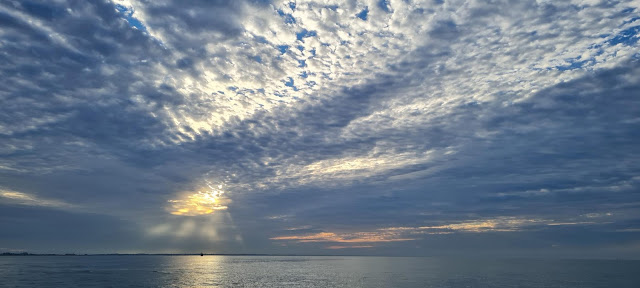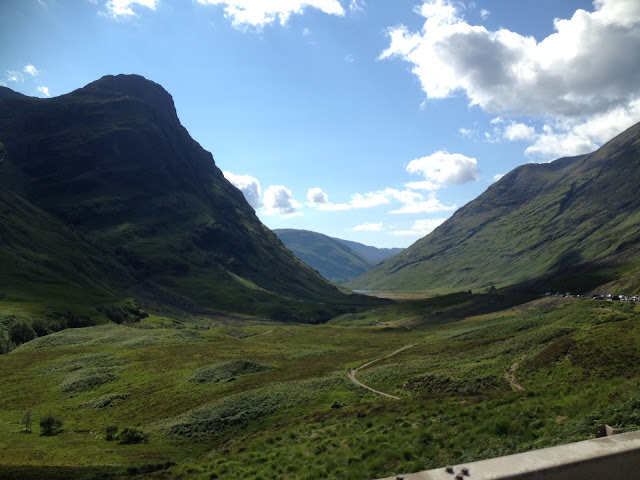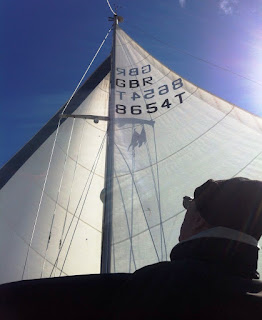Neptune's Staircase and a castle with a tale to tell
What a great name for this fearsome flight of eight locks or chambers, which took an hour and half to traverse. The first locking was 8am and the next wouldn’t be until about 1pm so we got up ready for the eight o’clock descent. The routine is that a crew member stays ashore and “walks" the boat through and this was what the lady lock keeper recommended. Josh wasn’t happy about this as he wanted us both to stay on the boat, however in the end after several requests from the lockkeepers he relented and I “walked” the boat through each lock. It was an overcast morning with a chilly wind so it was rather tedious and I got very cold, as there was a lot of standing around.
 |
| A lot of standing around in the cold. |
Once through the final lock, we went through the railway
swing bridge and then headed on down the canal to the sea lock. We had to wait to enter the sea lock while
the Danish boat refuelled and then we were in the final lock of the Caledonian Canal
 We had some
paperwork to sort out which the lockkeeper did while we were in the lock and
then the gates opened and we were in the salt waters of Loch Linnhe and saying goodbye to the Caledonian Canal. We
had a party of four other yachts who had done the descent with us: a small open
motor boat, crewed by two young fit Australian lads, tender to the £250 million
pound super yacht that we were told was waiting in the sea lock basin; a
Danish yacht; an aluminium French yacht and another small English yacht.
We had some
paperwork to sort out which the lockkeeper did while we were in the lock and
then the gates opened and we were in the salt waters of Loch Linnhe and saying goodbye to the Caledonian Canal. We
had a party of four other yachts who had done the descent with us: a small open
motor boat, crewed by two young fit Australian lads, tender to the £250 million
pound super yacht that we were told was waiting in the sea lock basin; a
Danish yacht; an aluminium French yacht and another small English yacht.
It remained overcast and chilly and as we said goodbye to Ben Nevis it was, as usual, shrouded in low cloud.
 We had some
paperwork to sort out which the lockkeeper did while we were in the lock and
then the gates opened and we were in the salt waters of Loch Linnhe and saying goodbye to the Caledonian Canal. We
had a party of four other yachts who had done the descent with us: a small open
motor boat, crewed by two young fit Australian lads, tender to the £250 million
pound super yacht that we were told was waiting in the sea lock basin; a
Danish yacht; an aluminium French yacht and another small English yacht.
We had some
paperwork to sort out which the lockkeeper did while we were in the lock and
then the gates opened and we were in the salt waters of Loch Linnhe and saying goodbye to the Caledonian Canal. We
had a party of four other yachts who had done the descent with us: a small open
motor boat, crewed by two young fit Australian lads, tender to the £250 million
pound super yacht that we were told was waiting in the sea lock basin; a
Danish yacht; an aluminium French yacht and another small English yacht. |
| The "super yacht" moored in the Corpach basin and the Danish boat. |
The wind
was “on the nose” of course, so we motored on past Fort William
I am now in the habit of sampling the local gins, this one was really nice. Due to the small batches that are made you have to come up here to sample it, it isn't available in supermarkets.
The owner of the pub also owns the castle and boat trips can be arranged with a tour by the owner. The castle is named Castle Stalker, Gaelic for hunter or falconer, and it has been restored and is one of the many “Island Castles” in this region of NW Scotland. The story goes that the clan owner gave it away to the leader of a rival clan in a drunken bet! It was also theCastle of Arrgggh Nova Scotia North America ! All this discovered on a short walk to the local pub in the wilds of NW Scotland
I am now in the habit of sampling the local gins, this one was really nice. Due to the small batches that are made you have to come up here to sample it, it isn't available in supermarkets.
The owner of the pub also owns the castle and boat trips can be arranged with a tour by the owner. The castle is named Castle Stalker, Gaelic for hunter or falconer, and it has been restored and is one of the many “Island Castles” in this region of NW Scotland. The story goes that the clan owner gave it away to the leader of a rival clan in a drunken bet! It was also the
From Wikipedia and the barman at the Old Inn.
Castle Stalker (Scottish Gaelic: Caisteal an Stalcaire) is a four-story tower house or keep picturesquely set on a tidal islet on Loch Laich, an inlet off Loch Linnhe. It is about 1.5 miles (2.4 km) north-east of Port Appin, Argyll,
In recent times, the castle was brought to fame by the Monty Python team, appearing in their film Monty Python and the Holy Grail.
The island castle's picturesque appearance, with its bewitching island setting against a dramatic backdrop of mountains, has made it a favourite subject for postcards and calendars, and something of a cliché image of Scottish Highland scenery. Castle Stalker is entirely authentic; it is one of the best-preserved medieval tower-houses surviving in western
History
The original castle was a small fort, built around 1320 by Clan MacDougall who were then Lords of Lorn.[3] Around 1388 the Stewarts took over the Lordship of Lorn, and it is believed that they built the castle in its present form around the 1440s. The Stewart's relative King James IV of Scotland visited the castle, and a drunken bet around 1620 resulted in the castle passing to Clan Campbell. After changing hands between these clans a couple of times the
For the 2011 census the island on which the castle stands was classified by the National Records of Scotland as an inhabited island that "had no usual residents at the time of either the 2001 or 2011 censuses."[4]
In
popular culture
While most castle scenes in the movie Monty Python and the Holy Grail (1975) were filmed in and around Doune Castle, Castle Stalker appears in the final scene as "The Castle of Aaaaarrrrrrggghhh". First the castle is seen from a distance; next, a French castle guard (John Cleese) taunts King Arthur (Graham Chapman) in a French accent from its battlements; finally, a massive attack is launched against the castle, after which police officers who were investigating the death of a historian earlier in the film arrive and are in the process of arresting Arthur and the other knights for killing him when one officer places his hand over the camera's lens cap and ends the film's visuals.
The castle also makes a brief appearance in the film Highlander: Endgame.[5]
Castle Stalker is the inspiration for "Castle Keep" in the children's book, The Boggart








Comments
Post a Comment